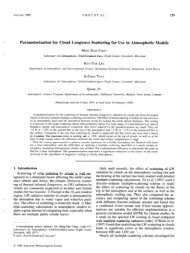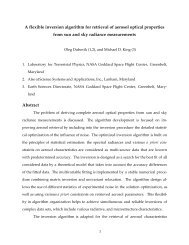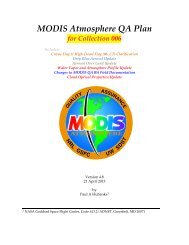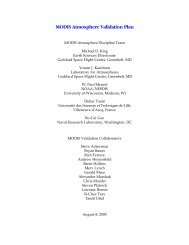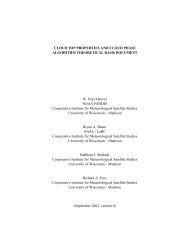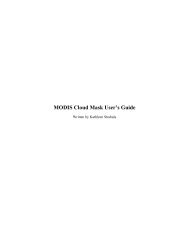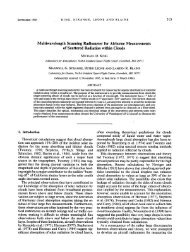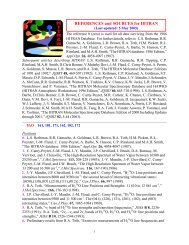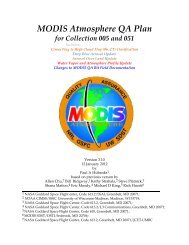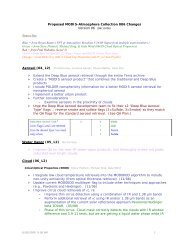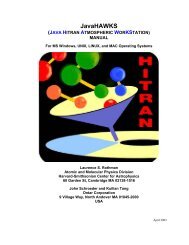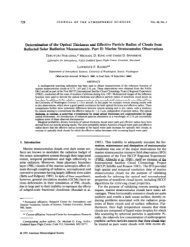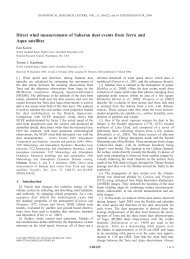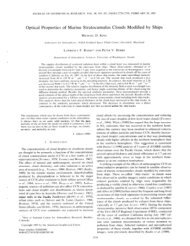Ackerman_et_al. - MODIS Atmosphere - NASA
Ackerman_et_al. - MODIS Atmosphere - NASA
Ackerman_et_al. - MODIS Atmosphere - NASA
You also want an ePaper? Increase the reach of your titles
YUMPU automatically turns print PDFs into web optimized ePapers that Google loves.
1078 JOURNAL OF ATMOSPHERIC AND OCEANIC TECHNOLOGY VOLUME 25<br />
TABLE 1. Cloud amount (60°S–60°N) as a function of<br />
reflectance biases and reflectance thresholds.<br />
Cloud amount<br />
Collection 5 cloud mask Water 72.7%<br />
Land 54.1%<br />
Increase <strong>al</strong>l B1 and B2 reflectance by 5% of Water 73.3%<br />
the origin<strong>al</strong> Land 54.6%<br />
Decrease <strong>al</strong>l B1 and B2 reflectance by 5% Water 72.2%<br />
of origin<strong>al</strong> Land 53.6%<br />
Increase VIS/nadir reflectance test threshold Water 70.7%<br />
by 1% Land 54.1%<br />
Decrease VIS/nadir reflectance test threshold Water 75.5%<br />
by 1% Land 54.7%<br />
cloud edges and subpixel clouds than do sm<strong>al</strong>ler IFOVs.<br />
To explore the impact of IFOV size on cloud d<strong>et</strong>ection,<br />
clear-sky fractions were d<strong>et</strong>ermined by increasing the<br />
<strong>MODIS</strong> IFOV from 1 km to larger groupings (e.g., 2<br />
km on a side, 4 km on a side, <strong>et</strong>c.), but cloud test thresholds<br />
were held constant. To be classified as clear in this<br />
an<strong>al</strong>ysis, <strong>al</strong>l <strong>MODIS</strong> pixels within a group were required<br />
to be labeled as confidently clear or probably<br />
clear. Figure 7 shows the percentage of clear sky on 5<br />
November 2000 as a function of these simulated footprint<br />
sizes. For the increased IFOV to be classified as<br />
clear, the reflectance has to satisfy the threshold s<strong>et</strong> by<br />
the 1-km pixel so the clear-sky amounts rapidly decrease<br />
with increasing footprint size. The v<strong>al</strong>ue in a<br />
6-km IFOV is typic<strong>al</strong>ly h<strong>al</strong>f that of a 1-km IFOV. IFOV<br />
size has a large impact on observed cloud amounts due<br />
to subpixel cloud fields. The subpixel effects can be<br />
ameliorated in an <strong>al</strong>gorithm by modifying the clear-sky<br />
threshold. Because IFOV size has a large impact on<br />
observed cloud amounts, care should be taken when<br />
comparing cloud fraction from sensors with differing<br />
IFOV sizes.<br />
Instrument swath widths <strong>al</strong>so impact estimates of<br />
glob<strong>al</strong> cloud amount distributions. To explore this impact<br />
on zon<strong>al</strong> clear-sky amounts, we computed clearsky<br />
fractions from 1-km <strong>MODIS</strong> observations during 16<br />
October–15 November 2003 using only pixels within 1°<br />
of nadir (extreme nadir) and pixels within 20° of nadir.<br />
Figure 8 d<strong>et</strong>ails differences in zon<strong>al</strong> mean clear-sky<br />
amounts during this period. As expected, the nadir<br />
sampling strategies result in greater clear-sky fractions,<br />
or less clouds, when compared to use of the entire<br />
swath width. Gener<strong>al</strong>ly, the difference b<strong>et</strong>ween the nadir<br />
views and the full swath is less than 5%. The impact<br />
of sampling is much larger on a region<strong>al</strong> sc<strong>al</strong>e as shown<br />
in Fig. 9, where differences in cloud amount for a 1°<br />
grid can differ by more than 30%. Thus, nadir and<br />
near-nadir viewing can produce similar zon<strong>al</strong> means but<br />
yield large differences region<strong>al</strong>ly.<br />
FIG. 7. The percentage of pixels labeled as confident clear or<br />
probably clear as a function of simulated pixel size using <strong>MODIS</strong><br />
data collected on 5 Nov 2000.<br />
The studies presented in this section provide insight<br />
into the sensitivity of the cloud mask <strong>al</strong>gorithm results<br />
to instrument characteristics and <strong>al</strong>gorithm thresholds.<br />
Awareness of this sensitivity is necessary for comparing<br />
the <strong>MODIS</strong> cloud d<strong>et</strong>ection to other observations covered<br />
in the next section.<br />
4. Comparison with lidar/radar observations<br />
a. Ground-based observations<br />
The performance of the <strong>MODIS</strong> cloud mask has<br />
been addressed in sever<strong>al</strong> recent papers (King <strong>et</strong> <strong>al</strong>.<br />
2003; Platnick <strong>et</strong> <strong>al</strong>. 2003; Lee <strong>et</strong> <strong>al</strong>. 2004; Li <strong>et</strong> <strong>al</strong>. 2007).<br />
In this section we compare <strong>MODIS</strong> cloud mask results<br />
with active sensors from ground, aircraft, and satellite<br />
platforms.<br />
Three years (2003–05) of the Collection 5 cloud mask<br />
<strong>al</strong>gorithm results were compared with those from the<br />
Department of Energy (DOE) Atmospheric Radiation<br />
Measurement (ARM) Program Active Remotely<br />
Sensed Cloud (ARSCL) product that combines<br />
ground-based observations from a micropulse lidar<br />
(MPL) and a millim<strong>et</strong>er-wavelength cloud radar<br />
(MMCR) to d<strong>et</strong>ermine cloud presence and cloud-top<br />
heights (Clothiaux <strong>et</strong> <strong>al</strong>. 2000). This investigation utilizes<br />
the ARSCL r<strong>et</strong>riev<strong>al</strong>s at the Southern Great<br />
Plains (SGP) site in Lamont, Oklahoma (Stokes and<br />
Schwartz 1994).<br />
The ARSCL <strong>al</strong>gorithm processes and combines data<br />
from the MPL and MMCR to d<strong>et</strong>ermine cloud-base<br />
and cloud-top <strong>al</strong>titude at a vertic<strong>al</strong> spati<strong>al</strong> resolution of<br />
45 m and a tempor<strong>al</strong> resolution of 10 s. The ARSCL<br />
<strong>al</strong>gorithm processes the four modes of MMCR operation<strong>al</strong><br />
output and merges it with the output of the MPL



